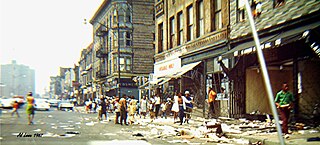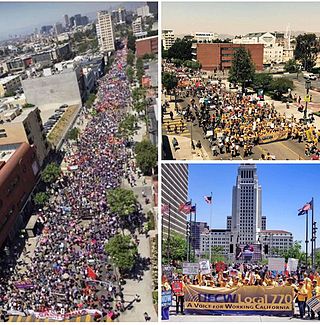Related Research Articles

Detroit is the most populous city in the U.S. state of Michigan. It is the largest U.S. city on the Canadian border and the county seat of Wayne County. Detroit had a population of 639,111 at the 2020 census, making it the 26th-most populous city in the United States. The Metro Detroit area, home to 4.3 million people, is the second-largest in the Midwest after the Chicago metropolitan area and the 14th-largest in the United States. A significant cultural center, Detroit is known for its contributions to music, art, architecture and design, in addition to its historical automotive background.
In the broader context of racism in the United States, mass racial violence in the United States consists of ethnic conflicts and race riots, along with such events as:

Flint is the largest city and seat of Genesee County, Michigan, United States. Located along the Flint River, 66 miles (106 km) northwest of Detroit, it is a principal city within the region known as Mid Michigan. At the 2020 census, Flint had a population of 81,252, making it the twelfth-most populous city in Michigan. The Flint metropolitan area is located entirely within Genesee County. It is the fourth-largest metropolitan area in Michigan with a population of 406,892 in 2020. The city was incorporated in 1855.

Royal Oak is a city in Oakland County in the U.S. state of Michigan. An inner-ring suburb of Detroit, Royal Oak is located roughly 14 miles (22.5 km) north of downtown Detroit. As of the 2020 census, the city had a population of 58,211.

Saginaw is a city in and the seat of Saginaw County, Michigan, United States. It had a population of 44,202 at the 2020 census. Located along the Saginaw River, Saginaw is adjacent to Saginaw Charter Township and considered part of Greater Tri-Cities region of Central Michigan. The Saginaw metropolitan area had a population of 190,124 in 2020, while the Tri-Cities area had 377,474 residents.

The 1967 Detroit riot, also known as the 12th Street Riot and the Detroit Uprising, was the bloodiest of the urban riots in the United States during the "long, hot summer of 1967". Composed mainly of confrontations between African American residents and the Detroit Police Department, it began in the early morning hours of Sunday July 23, 1967, in Detroit, Michigan.

The 1967 Newark riots were an episode of violent, armed conflict in the streets of Newark, New Jersey. Taking place over a four-day period, the Newark riots resulted in at least 26 deaths and hundreds more serious injuries. Serious property damage, including shattered storefronts and fires caused by arson, left many of the city's buildings damaged or destroyed. At the height of the conflict, the National Guard was called upon to occupy the city with tanks and other military equipment, leading to iconic media depictions that were considered particularly shocking when shared in the national press. In the aftermath of the riots, Newark was quite rapidly abandoned by many of its remaining middle-class and affluent residents, as well as much of its white working-class population. This accelerated flight led to a decades-long period of disinvestment and urban blight, including soaring crime rates and gang activity.
The Coalition to Defend Affirmative Action, Integration & Immigrant Rights, and Fight for Equality By Any Means Necessary, commonly shortened to By Any Means Necessary (BAMN), is a militant, American far-left group that participates in protests and litigation to achieve its aims. It is a front organization for the Revolutionary Workers League.

The 1943Detroit race riot took place in Detroit, Michigan, from the evening of June 20 through to the early morning of June 22. It occurred in a period of dramatic population increase and social tensions associated with the military buildup of U.S. participation in World War II, as Detroit's automotive industry was converted to the war effort. Existing social tensions and housing shortages were exacerbated by racist feelings about the arrival of nearly 400,000 migrants, both African-American and White Southerners, from the Southeastern United States between 1941 and 1943. The migrants competed for space and jobs against the city's residents as well as against European immigrants and their descendants. The riot escalated after a false rumor spread that a mob of whites had thrown a black mother and her baby into the Detroit River. Blacks looted and destroyed white property as retaliation. Whites overran Woodward to Veron where they proceeded to violently attack black community members and tip over 20 cars that belonged to black families.
Riots often occur in reaction to a perceived grievance or out of dissent. Riots may be the outcome of a sporting event, although many riots have occurred due to poor working or living conditions, government oppression, conflicts between races or religions.

The Detroit Police Department (DPD) is the primary law enforcement agency of the city of Detroit, Michigan, United States. Founded in 1865, it has nearly 2,500 officers, making it the largest law enforcement organization in the state.

The long, hot summer of 1967 refers to a period of widespread racial unrest across major American cities during the summer of 1967, where over 150 riots erupted, primarily fueled by deep-seated frustrations regarding police brutality, poverty, and racial inequality within Black communities. This term highlights the intensity and widespread nature of the urban violence that summer.

The Grand Rapids Police Department is a municipal police department within Grand Rapids in the state of Michigan, United States.

The 2017 May Day protests were a series of protests that took place on May Day over worker and immigrant rights, throughout the United States and around the world. Protests became violent in Olympia, Washington, and Portland, Oregon. Many demonstrators were protesting against the policies of President Donald Trump, specifically those related to immigration.
Events from the year 1885 in Michigan.

The term ghetto riots, also termed ghetto rebellions, race riots, or negro riots refers to a period of widespread urban unrest and riots across the United States in the mid-to-late 1960s, largely fueled by racial tensions and frustrations with ongoing discrimination, even after the passage of major Civil Rights legislation; highlighting the issues of racial inequality in Northern cities that were often overlooked in the earlier focus on the Southern states.

This is a list of protests that took place in Michigan in 2020 following the murder of George Floyd.
References
- ↑ Willie L Mckether Susanne Friese. "Riot/Rebellion in Downtown Saginaw, Michigan 1967 – Figure 1 of 1" . Retrieved May 8, 2017.
- 1 2 3 "Saginaw Politics – Michigan History". Michiganhistory.leadr.msu.edu. July 26, 1967. Retrieved May 8, 2017.
- 1 2 Salas, Andrew. "Mid-Michigan Remembers". Websites.delta.edu. Retrieved May 8, 2017.
- 1 2 "July 26, 1967 – Violence Spreads to Other Cities in Michigan | Chicago Tribune Archive". Archives.chicagotribune.com. July 26, 1967. Retrieved May 8, 2017.